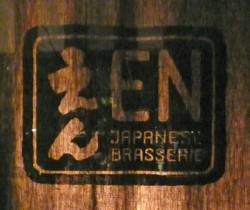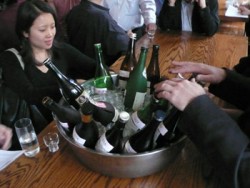Joy of Sake Aftertaste 2: Balance & Harmony
 The folks at Joy of Sake don’t just stick to their one mega sake tasting event each year. Lucky for us, they also have smaller get togethers they call “Aftertaste” events, each usually focused on a new sake-related theme. Last June, I attended a Joy of Sake Aftertaste event devoted to “Umami”.
The folks at Joy of Sake don’t just stick to their one mega sake tasting event each year. Lucky for us, they also have smaller get togethers they call “Aftertaste” events, each usually focused on a new sake-related theme. Last June, I attended a Joy of Sake Aftertaste event devoted to “Umami”.
However, last week, I was lucky enough to attend the latest Aftertaste event being held at En Japanese Brasserie. This event focused on the concept of “Balance and Harmony” in sake. This is the event description from the invite:
One characteristic all prize-winning sakes possesses is “balance.†For most sake judges, balance is more important than either taste or aroma. But what exactly is it that is in balance? And how can we tell if a sake is balanced or unbalanced? This month’s tasting explores one of the more elusive concepts in sake appreciation.
 Balance in Sake
Balance in Sake
It’s true! Balance is something that’s very prized in the world of sake. I look at balance as finding the most pleasant equilibrium between sweetness and acidity as well as richness and lightness.
So what sakes were on tap to explain “Balance and Harmony”? Let’s take a look at some highlights! Check out these sakes if you want to find some Balance and Harmony of your own!
![]() Tentaka “Silent Stream” Junmai Daiginjo: From Tochigi Prefecture. This sake won a silver award in the 8th US National Sake Appraisal.
Tentaka “Silent Stream” Junmai Daiginjo: From Tochigi Prefecture. This sake won a silver award in the 8th US National Sake Appraisal.
![]() Shichihonyari Junmai: From Shiga Prefecture. This sake won a silver award in the 8th US National Sake Appraisal.
Shichihonyari Junmai: From Shiga Prefecture. This sake won a silver award in the 8th US National Sake Appraisal.
Dassai 50 Junmai Ginjo: From Yamaguchi Prefecture. This sake won a gold award in the 8th US National Sake Appraisal.
![]() Taiheikai Tokubetsu Junmai: From Ibaraki Prefecture. This sake won a gold award in the 8th US National Sake Appraisal.
Taiheikai Tokubetsu Junmai: From Ibaraki Prefecture. This sake won a gold award in the 8th US National Sake Appraisal.
Here’s to lots of “balance and harmony” in your sake drinking experiences!


